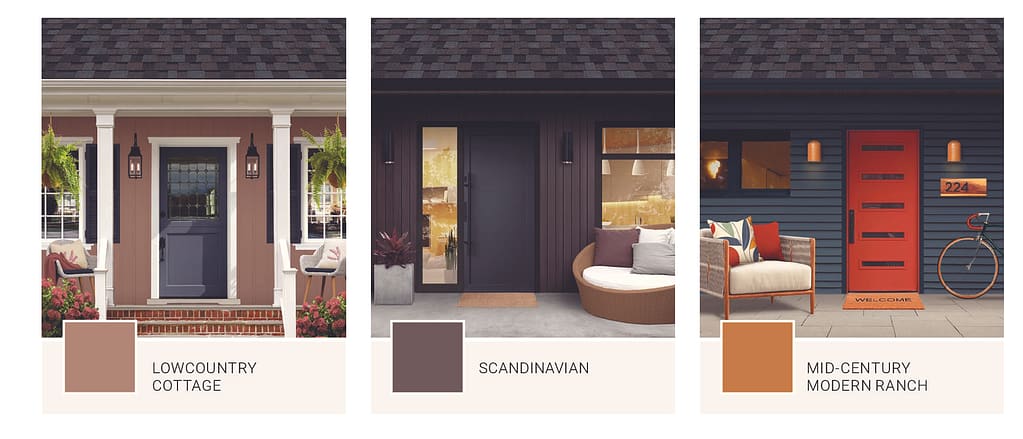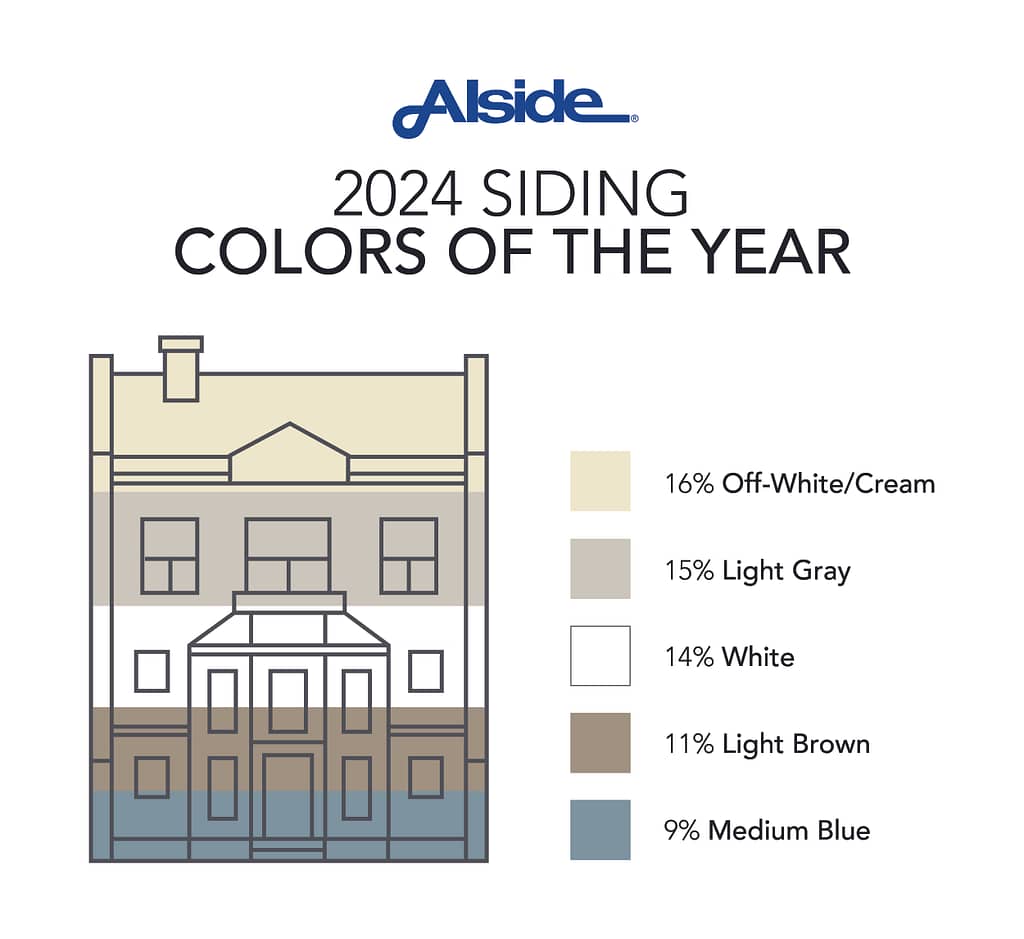OLD IDEAS BECOME NEW AGAIN

Owens Corning unveiled “Williamsburg Gray,” infused with slate grays, volcanic black shades, and earthy browns, as the 2024 Shingle Color of the Year (SCOTY).
The style boards illustrate how a home’s roof can contribute to its design ethos. The desired look can be a quaint low- country cottage aesthetic, a sleek and minimalist Scandinavian vibe, or a mid-century modern ranch effect.
The images underscore the important role that exterior doors play. Style, material, hardware and paint color are factors to consider.
Minimalism in the 20th Century
Reading articles about 2024 home styles, you might find such statements as, “The style is influenced by the zen simplicity of traditional Japanese gardens.” Or, “The interiors and the clean aesthetics of Scandinavian design were key factors.” But these statements were made about the minimalist design concepts in the early 20th century!
20th century modern/minimalist home styles were a rejection of excessive ornamentation. The prevalent Victorian style at that time was replaced by Modernist architecture. It was an about-face with its focus on clean lines and geometric shapes. The Bauhaus movement marked an important period. Its motive was to integrate art, craft, and technology. Materials that were new and cutting-edge at the time were introduced
The Craftsman and mid-century modern styles soon evolved. These styles are not typically considered minimalist in the same sense as the styles mentioned earlier. But they do share some of the same elements of simplicity and functionality with a focus on clean lines. The emphasis on natural materials, open spaces, and a connection to the outdoors also aligns these styles with the principles of minimalism. But they are somewhat of transitional styles which often did include a few more decorative elements.
Wikipedia defines Minimal Traditional as a style of architecture that emerged in mid 20th century America. It incorporates influences from earlier styles while also avoiding excessive ornamentation. These homes were usually smaller-scale, detached single-family houses with hipped or gabled roofs. The homes were clad in locally popular materials such as wood, brick or stone. Small porches and an asymmetrical design with the front door set off center are also hallmarks of this style movement.
21st Century Minimalism Represents Another Push-Back
As they say, history repeats itself. And the beginning of the 21st century is proving that statement to be true. The modern century’s push-back came against the over-accessorized, ornately detailed homes of the McMansion era. The “Less is More” attitude followed the Great Recession in the first decade of the new Millennium. Contemporary designs embodied the principles of minimalism once again.
With the second decade of the new millennium came the world pandemic. “Wellness” became the primary driver of everything, attitudes and preferences. All this aligns perfectly with the principles of minimalism–the use natural materials, open spaces, and a connection to the outdoors. But while minimalist designs continue to influence our home styles, those that are too simplistic start to feel cold, soulless, and empty. The pandemic left buyers seeking more comfort and warmth. So we’ve witnessed remodeling activity and new home designs gravitate toward more transitional styles. A richer color palate and the more details are driven by the yearning for self-expression.
The ability to visualize exterior product selections for a new home exterior or before making changes to a home’s exterior is a huge advantage. Modern visualization software can help assure a successful project and help avoid costly mistakes.
ACHIEVING THE LOOK



Check out Glen Gery’s 2024 Brick Styles Catalog – a collection of trending brick styles, colors and new products for the year.

History Revisited by Modern Building Products
It dates back nearly 200 years, but board and batten siding is still all over today’s Pinterest boards and Instagram feeds. It is widely used on popular farmhouse styles. But is is also a go-to in the popular practice of blending various textures, finishes and materials.
Traditional board and batten siding starts with wide vertical planks (boards). They are joined together by thin vertical strips (battens) to cover the seams. Farmers were among the first to embrace the style when building barns. The technique was inexpensive, assembly was relatively simple, and the result was energy efficient. They simply nailed up long boards and used battens over the seams to make the structure as airtight as possible.
Today, the wide panels may be the primary siding. They are made of more durable products that simulate wood, whether it be vinyl, metal or fiber cement. And the batten strips are usually just decorative. Designers play with spacing, colors, and siding profiles to achieve personalized and unique looks.
Siding made of recycled vinyl, engineered wood and fiber cement is just one example. Innovations are a response to the growing demand for high-performance, weather-resistant building products. Similarly, synthetic slate, composite shingles, and modern metal roof panels are other examples. As climate change continues to intensify and lead to severe weather events, we substitute great-looking and much more resilient materials that still deliver historically accurate looks for any homestyle.

Mixed textures and materials and color contrast

Brick or stucco paired with metal or wood softens modern, minimalist façades, provides texture, and blurs the lines between indoor and outdoor living. And stone adds visual interest.
Using color as an accent is an easy way to liven up a neutral monochromatic façade. Some home designs are shirking the traditional neutrals for a darker palate, such as midnight blue, forest green, dark brown, charcoal gray or true black. On a dark façade, white accents pop. And once again, combining nature-inspired materials adds organic texture and warmth.
Updating Home Exteriors
In the pursuit of modernizing home exteriors, the common practice of painting brick has gained popularity due to its transformative effect,” says Katie Bacon, a residential designer at Kitchen Design Concepts in Dallas. “However, for those seeking to uphold the integrity and inherent qualities of brick, techniques such as applying slurry, a mix with thick texture imparting a mortar-like appearance, offer a compelling solution. Through a power washing process, the brick is lightened while maintaining its essential properties.”
Bacon also mentioned that another noteworthy choice is Romabio, a mineral-based wash that allows the brick to breathe, preserving its natural characteristics while imparting a subtle sheen or pearl-like finish. “These alternatives serve to enhance exteriors without compromising the quality of the original brick, providing a nuanced and stylish solution for modern home aesthetics.” Bacon adds.
WHAT’S NEXT? MINALISM OR MAXIMALISM?
New interpretations of mid-century modern design remain popular. Scandinavian design, known for its emphasis on light colors, natural materials, and a clean aesthetic, are a prevalent influence. Other designs draw inspiration from industrial styles featuring exposed brick, metal elements, and open spaces. Farmhouse-style homes combining rustic elements with modern conveniences remain popular.
But for 2024, some experts predict a shift away from designs inspired by minimalism. Whimsical, nostalgic, personal touches are overdue, and we can expect to see this impact both home exteriors and interiors, some predict. Many designers anticipate classic traditional styles reinterpreted with a modern touch. Some even say we’ll return to maximalism as the next push-back against a long wave of minimalism.
The true experts concur that there is no need to entirely wed ourselves to one school of thought or another. Design is really a personal point of view. Thus, as we approach the quarter-century mark, the predominant styles are a blending of various design influences.
